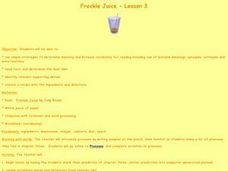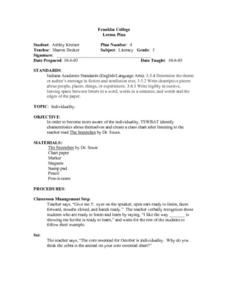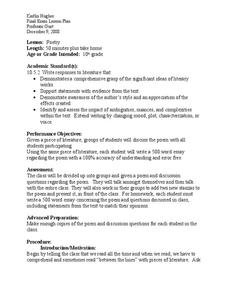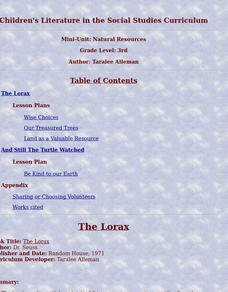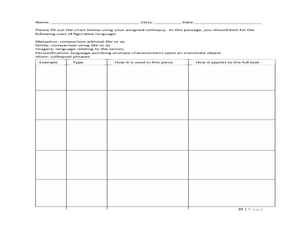Curated OER
Needs and Wants
Students demonstrate responsible consumer choices. In this social studies instructional activity, students read The Lorax and discuss wants and needs. Students discuss how to save natural resources by making informed consumer choices.
Curated OER
You Gotta Have A Hat
First graders compare versions of the folktale, 'Caps for Sale.' After listening to both stories, 1st graders utilize a Venn Diagram imbedded in this lesson to produce a graphic organizer detailing the similarities and differences...
Curated OER
Solid Waste and Our Natural Resources: Utilizing the Story THE LORAX
Students gain an introduction to our planet's solid waste problem and our personal responsibility in curbing and solving said problem through the use of Dr. Seuss' book, The Lorax. After hearing the book, class discussion follows.
Curated OER
Freckle Juice - Lesson 3
Students complete activities with the book Freckle Juice by Judy Blume. In this literature lesson, students read Chapter two and find the definitions for new vocabulary words. They also complete an online activity for...
Curated OER
Wild Things
Students draw a literacy response picture demonstrating knowledge and appropriate use of computer hardware components (monitor, mouse) using KidPix and Kidspiration software with a minimum of two different pictorial details on their...
Curated OER
What Are We Reading for Again?
Learners work to develop comprehension strategies. Through modeling and guided practice they develop a series of questions as they read Where the Wild Things Are. They apply these questions to find answers about the text and make...
Curated OER
Musicians and Vampires
Students practice techniques and strategies for understanding the parts of a story to help them remember what they've read. They review and analyze the elements of a story and how to find them first in a paragraph and then in a book.
Curated OER
Counting
Second graders comprehend how to use two different kinds of graphs. They complete a worksheet with the help of the teacher and a bag of jellybeans and then another worksheet without the direction of the teacher. Students listen as the...
Curated OER
Language Arts: What Makes an Individual
Third graders listen to the teacher read "The Sneetches" prior to creating charts about their individual characteristics. After numerous examples of individuality, they compile them on chart paper. As an extension, 3rd graders write...
Curated OER
The Importance of the Rainforest
Students read "The Great Kapok Tree" by Lynne Cherry while listening to Tropical Rainforest music. They name all the speaking animals in the book and list each of the reasons the animals gave for not cutting down the tree. They then...
Curated OER
The Little Red Hen
Students review the of "The Little Red Hen," to make sure that they comprehend that the hen's three friends were the cat, the dog, and the goose. They experiment with character vocies. Students are asked how the gossipy goose would...
Curated OER
Children in Hiding During the Holocaust
Students examine the different ways in which children hid trying to escape the concentration camps. Using journal entries, they put themselves into the role of the children and imagine their feelings during the Holocaust. They discuss...
Curated OER
All About Bugs
Students read "The Very Hungry Caterpillar" and practice the days of the week. In groups, they create a puppet show, design cards of the "days of the week," draw their favorite part of the story, create a visual representation of each...
Curated OER
Poet Naomi Shihab Nye
Learners read and analyze poetry by Naomi Shihab Nye. They define stereotypes, view and discuss a video interview with Nye, present an oral reading of a poem, and write a persuasive letter to an author.
Curated OER
Poetry
Tenth graders write a poem. In this poetry lesson, 10th graders read the poem The Road Not Taken written by Robert Frost, answer discussion questions, add new stanzas to the poem and share them with the class.
Curated OER
Checkmate
Students start identifying the cause and effect relationships in games of Chess. Using the internet, they research the history of the game and how the roles for each of the pieces. They develop a skit based on the roles and...
Curated OER
Koala Lou
In this making and analyzing lists learning exercise, students list things mothers do to take care of them, identify the most important and tell why, list things the koala's mother does to take care of her, identify the ones that apply...
Curated OER
Madame Bovary by Gustave Flaubert
For this literature worksheet, students respond to 12 short answer and essay questions about Flaubert's Madame Bovary. Students may also link to an online interactive quiz on the novel at the bottom of the page.
Curated OER
Animal Farm
An exploration of "Animal Farm" can be a way to get students thinking about politics, history, and literature.
Curated OER
My Brother Sam is Dead: A study of the Revolutionary War
Fifth graders complete an analysis of the Revolutionary War through literature. After "My Brother Sam Is Dead," students create a time capsule containing items that would be relevant during the Revolutionary War. They identify key...
Curated OER
Dealing with Differences
Learners list at least ten things they have a hard time doing. After reading and discussing Be Good to Eddie Lee, Students, in cooperative groups, write at least six ways people can assist people with disabilities.
Curated OER
Debunking the Myth of the American West
Students participate in a close reading. They examine the text closely for implied and hidden meaning, dissect the story to understand the text as a written craft, and discuss significant details and overall meaning of story. They...
Curated OER
Land as a Valuable Resource
Students investigate why the soil is important to our lives. In this natural resources lesson plan, students have a farmer as a guest speaker. Students begin to understand how farmers use and protect our natural resource. Students write...
Curated OER
Soliloquy Performances
Students investigate soliloquies. In this performing arts lesson, students discuss figurative language within soliloquies and then perform a soliloquy to the rest of the class.





